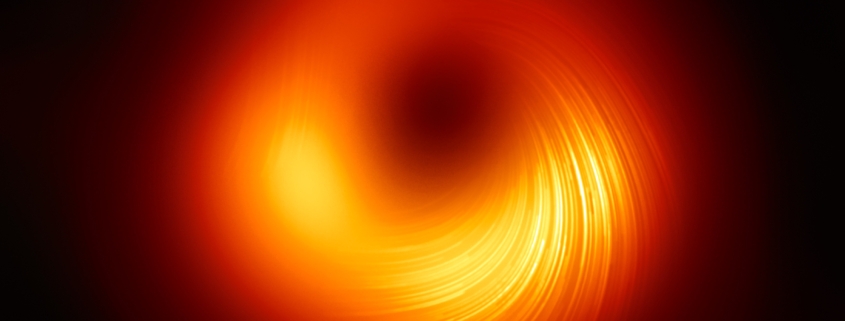The Event Horizon Telescope (EHT) collaboration, who produced the first ever image of a black hole, has today revealed a new view of the massive object at the centre of the Messier 87 (M87) galaxy: how it looks in polarised light. This is the first time astronomers have been able to measure polarisation, a signature of magnetic fields, this close to the edge of a black hole. The observations are key to explaining how the M87 galaxy, located 55 million light-years away, is able to launch energetic jets from its core.
“We are now seeing the next crucial piece of evidence to understand how magnetic fields behave around black holes, and how activity in this very compact region of space can drive powerful jets that extend far beyond the galaxy,” says Monika Mościbrodzka, Coordinator of the EHT Polarimetry Working Group and Assistant Professor at Radboud University in the Netherlands.
On 10 April 2019, scientists released the first ever image of a black hole, revealing a bright ring-like structure with a dark central region — the black hole’s shadow. Since then, the EHT collaboration has delved deeper into the data on the supermassive object at the heart of the M87 galaxy collected in 2017. They have discovered that a significant fraction of the light around the M87 black hole is polarised.
“This work is a major milestone: the polarisation of light carries information that allows us to better understand the physics behind the image we saw in April 2019, which was not possible before,” explains Iván Martí-Vidal, also Coordinator of the EHT Polarimetry Working Group and GenT Distinguished Researcher at the University of Valencia, Spain. He adds that “unveiling this new polarised-light image required years of work due to the complex techniques involved in obtaining and analysing the data.”
Light becomes polarised when it goes through certain filters, like the lenses of polarised sunglasses, or when it is emitted in hot regions of space where magnetic fields are present. In the same way that polarised sunglasses help us see better by reducing reflections and glare from bright surfaces, astronomers can sharpen their view of the region around the black hole by looking at how the light originating from it is polarised. Specifically, polarisation allows astronomers to map the magnetic field lines present at the inner edge of the black hole.
“The newly published polarised images are key to understanding how the magnetic field allows the black hole to ‘eat’ matter and launch powerful jets,” says EHT collaboration member Andrew Chael, a NASA Hubble Fellow at the Princeton Center for Theoretical Science and the Princeton Gravity Initiative in the US.
The bright jets of energy and matter that emerge from M87’s core and extend at least 5000 light-years from its centre are one of the galaxy’s most mysterious and energetic features. Most matter lying close to the edge of a black hole falls in. However, some of the surrounding particles escape moments before capture and are blown far out into space in the form of jets.
Astronomers have relied on different models of how matter behaves near the black hole to better understand this process. But they still don’t know exactly how jets larger than the galaxy are launched from its central region, which is comparable in size to the Solar System, nor how exactly matter falls into the black hole. With the new EHT image of the black hole and its shadow in polarised light, astronomers managed for the first time to look into the region just outside the black hole where this interplay between matter flowing in and being ejected out is happening.
The observations provide new information about the structure of the magnetic fields just outside the black hole. The team found that only theoretical models featuring strongly magnetised gas can explain what they are seeing at the event horizon.
“The observations suggest that the magnetic fields at the black hole’s edge are strong enough to push back on the hot gas and help it resist gravity’s pull. Only the gas that slips through the field can spiral inwards to the event horizon,” explains Jason Dexter, Assistant Professor at the University of Colorado Boulder, US, and Coordinator of the EHT Theory Working Group.
To observe the heart of the M87 galaxy, the collaboration linked eight telescopes around the world — including the northern Chile-based Atacama Large Millimeter/submillimeter Array (ALMA) and the Atacama Pathfinder EXperiment (APEX), in which the European Southern Observatory (ESO) is a partner — to create a virtual Earth-sized telescope, the EHT. The impressive resolution obtained with the EHT is equivalent to that needed to measure the length of a credit card on the surface of the Moon.
“With ALMA and APEX, which through their southern location enhance the image quality by adding geographical spread to the EHT network, European scientists were able to play a central role in the research,” says Ciska Kemper, European ALMA Programme Scientist at ESO. “With its 66 antennas, ALMA dominates the overall signal collection in polarised light, while APEX has been essential for the calibration of the image.”
“ALMA data were also crucial to calibrate, image and interpret the EHT observations, providing tight constraints on the theoretical models that explain how matter behaves near the black hole event horizon,” adds Ciriaco Goddi, a scientist at Radboud University and Leiden Observatory, the Netherlands, who led an accompanying study that relied only on ALMA observations.
The EHT setup allowed the team to directly observe the black hole shadow and the ring of light around it, with the new polarised-light image clearly showing that the ring is magnetised. The results are published today in two separate papers in The Astrophysical Journal Letters by the EHT collaboration. The research involved over 300 researchers from multiple organisations and universities worldwide.
“The EHT is making rapid advancements, with technological upgrades being done to the network and new observatories being added. We expect future EHT observations to reveal more accurately the magnetic field structure around the black hole and to tell us more about the physics of the hot gas in this region,” concludes EHT collaboration member Jongho Park, an East Asian Core Observatories Association Fellow at the Academia Sinica Institute of Astronomy and Astrophysics in Taipei.
More information
This research was presented in two papers by the EHT collaboration published today in The Astrophysical Journal Letters:
“First M87 Event Horizon Telescope Results VII: Polarization of the Ring” (doi: 10.3847/2041-8213/abe71d)
“First M87 Event Horizon Telescope Results VIII: Magnetic Field Structure Near The Event Horizon” (doi: 10.3847/2041-8213/abe4de).
Accompanying research is presented in the paper
“Polarimetric properties of Event Horizon Telescope targets from ALMA” (doi: 10.3847/2041-8213/abee6a) by Goddi, Martí-Vidal, Messias, and the EHT collaboration, which has been accepted for publication in The Astrophysical Journal Letters.
The EHT collaboration involves more than 300 researchers from Africa, Asia, Europe, North and South America. The international collaboration is working to capture the most detailed black hole images ever obtained by creating a virtual Earth-sized telescope. Supported by considerable international investment, the EHT links existing telescopes using novel systems — creating a fundamentally new instrument with the highest angular resolving power that has yet been achieved.
The individual telescopes involved are: ALMA, APEX, the Institut de Radioastronomie Millimetrique (IRAM) 30-meter Telescope, the IRAM NOEMA Observatory, the James Clerk Maxwell Telescope (JCMT), the Large Millimeter Telescope (LMT), the Submillimeter Array (SMA), the Submillimeter Telescope (SMT), the South Pole Telescope (SPT), the Kitt Peak Telescope, and the Greenland Telescope (GLT).
The EHT consortium consists of 13 stakeholder institutes: the Academia Sinica Institute of Astronomy and Astrophysics, the University of Arizona, the University of Chicago, the East Asian Observatory, Goethe-Universitaet Frankfurt, Institut de Radioastronomie Millimétrique, Large Millimeter Telescope, Max Planck Institute for Radio Astronomy, MIT Haystack Observatory, National Astronomical Observatory of Japan, Perimeter Institute for Theoretical Physics, Radboud University and the Smithsonian Astrophysical Observatory.
The Atacama Large Millimeter/submillimeter Array (ALMA), an international astronomy facility, is a partnership of ESO, the U.S. National Science Foundation (NSF) and the National Institutes of Natural Sciences (NINS) of Japan in cooperation with the Republic of Chile. ALMA is funded by ESO on behalf of its Member States, by NSF in cooperation with the National Research Council of Canada (NRC) and the Ministry of Science and Technology (MOST) and by NINS in cooperation with the Academia Sinica (AS) in Taiwan and the Korea Astronomy and Space Science Institute (KASI). ALMA construction and operations are led by ESO on behalf of its Member States; by the National Radio Astronomy Observatory (NRAO), managed by Associated Universities, Inc. (AUI), on behalf of North America; and by the National Astronomical Observatory of Japan (NAOJ) on behalf of East Asia. The Joint ALMA Observatory (JAO) provides the unified leadership and management of the construction, commissioning and operation of ALMA.
The BlackHoleCam research group was awarded the European Research Council €14 million Synergy Grant in 2013. The Principal Investigators are Heino Falcke, Luciano Rezzolla and Michael Kramer and the partner institutes are JIVE, IRAM, MPE Garching, IRA/INAF Bologna, SKA and ESO. BlackHoleCam is part of the Event Horizon Telescope collaboration.
Links
- Research papers
- Additional videos related to the research on the EHT YouTube channel
- EHT website
- Images of ALMA
- Images of APEX
- ESO EHT webpage
- ESO blog post on the EHT project
- For scientists: got a story? Pitch your research
Originally published by ESO March 24, 2021

 EHT
EHT



